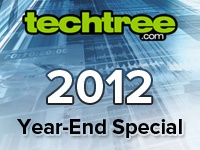-
Jayesh Limaye
04th Jan 2013
Has the advent of laptops and now tablets killed the good old PC for good? Many have predicted the death of the personal computer as we know it, and perhaps one day it will become obsolete – or, more likely, evolve into something else altogether. But for now, the PC is staying (even if it is losing market share to laptops). Here's a gist of the PC hardware developments of 2012.
AMD vs Intel, again
AMD built on its Fusion concept in which a basic GPU is combined with the CPU to achieve power efficiency and a lower cost for the user (since motherboards need not have a graphics chip). Recently in September, the company even launched a new socket type called FM2 for their APU chips (technically you cannot call them CPU because they contain more than a central processing unit). This new socket is not backwards compatible.Intel, on its part made its already commendable Sandy Bridge even more power efficient with the new Ivy Bridge, which is basically a die-shrink of the same architecture to the new 22 micron fabrication process, resulting in a claimed 50% lower power consumption. Not the ones to be left behind in the APU development, Intel brought in DirectX 11, OpenGL 3.1, and 4K video playback support in the integrated graphics on-board the CPU. The good news is that these new Core i5 and Core i7 processors are compatible with the existing LGA 1155 socket, thus making it possible to upgrade to them on a motherboard that is a generation old.
As expected, laptops outsold desktops, but desktop fans (yes, such a breed exists) need not fear – like we said, desktops are not going away in the near future. One trend worth mentioning is that, while the recent years saw laptop prices plummet, in 2012, some models went below the price of desktops from the same manufacturer (Lenovo being an example). Yes, you can get a 15.6 inch laptop for under Rs 20,000, which is more money than what a decent entry level desktop should cost. Clearly, those who are still sticking to desktops do so because they see the advantages of it (larger screen, better laid out keyboard, etc), lending more credence to our prediction that the desktop is not dying anytime too soon.
After Laptops And Netbooks, Now Come Ultrabooks
Ultrabooks have been marketed as sub-laptops that are closer in size to netbooks, but are as powerful as full-size laptops. They are certainly faster, thanks to SSDs, and also consume less power with special low-power CPUs from Intel that are made exclusively for Ultrabooks. While there is no doubt that they do look great and can give the MacBook a run for the money, they are still expensive and the Indian consumers' buying decision is heavily motivated by the price factor. Even with newer stylish models running Windows 8 and sporting gorgeous Full HD touchscreens, Ultrabooks are yet to catch the consumers' fancy here.In related news, gaming laptops became an extinct species in India, with users preferring desktops instead for gaming.
Storage Nearly Stagnant
Storage didn't really see much happening this year. SSDs have not yet caught on, owing to the huge difference in cost per GB (relative to hard disk). SSD priced dropped this year, but for most people (some enthusiasts included), the difference in performance is still not worth the cost. Give these rugged storage devices another round of price cuts, and we'll certainly see the adoption rate going up.Sheer capacity-wise, 4 TB remained the highest capacity HDD from last year, while SSDs have internationally seen capacities up to 2 TB. As far as external storage interface is concerned, USB 3.0 is fast becoming the de facto standard due to its faster speed even when used with the older USB 2.0 interface. It is surprising that some USB storage devices are still available with just the USB 2.0 Hi-Speed spec, and the same device with USB 3.0 is only marginally costlier, the price difference usually being not more than a couple of hundred rupees. We strongly suggest you go for the USB 3.0 versions because there is simply no reason not to.
Video Cards Get More Powerful, Business As Usual
Gamers had a good year with NVIDIA and AMD releasing graphics cards based around more powerful graphics chips. AMD switched to 28 nm manufacturing process for its Southern Islands family of graphics chips, also branded as the Radeon HD 7000 Series. The Radeon GPUs are known for their huge number of stream cores, with the high-end HD 7970 having 2048 stream processor (think of each stream processor as a small specialized CPU). In addition to providing the muscle for gaming, this gives them a huge potential of being used in other applications where the GPU can be used to perform massively parallel computations.When AMD launches some powerful cards, can its arch rival (since the erstwhile ATI days) be far behind? NVIDIA launched the GeForce 600 Series with the GeForce GTX640M and GTX680 — touted to be the most powerful single-core graphics cards to date. This series was introduced with the aim of improved energy efficiency. A dual chip version GTX690 with two GTX680 GPUs was also launched for those who want to go overboard. NVIDIA continues with its 3D push with 3D Vision 2, which is only compatible with systems with NVIDIA graphics cards.
This summarises the 2012 developments in PC hardware; the next part in this series will talk about display technologies.
Hardware, 3D, Laptops, Desktops, Storage, Graphics Cards, Intel, AMD, NVIDIA, 2012 Special, Jayesh
2012 TechTree Wrap-Up Part 3: PC Hardware Takes The Beaten Path | TechTree.com
2012 TechTree Wrap-Up Part 3: PC Hardware Takes The Beaten Path
Of ultrabooks, new processors, SSD prices and more.
News Corner
- DRIFE Begins Operations in Namma Bengaluru
- Sevenaire launches ‘NEPTUNE’ – 24W Portable Speaker with RGB LED Lights
- Inbase launches ‘Urban Q1 Pro’ TWS Earbuds with Smart Touch control in India
- Airtel announces Rs 6000 cashback on purchase of smartphones from leading brands
- 78% of Indians are saving to spend during the festive season and 72% will splurge on gadgets & electronics
- 5 Tips For Buying A TV This Festive Season
- Facebook launches its largest creator education program in India
- 5 educational tech toys for young and aspiring engineers
- Mid-range smartphones emerge as customer favourites this festive season, reveals Amazon survey
- COLORFUL Launches Onebot M24A1 AIO PC for Professionals







Reader Comments (2)